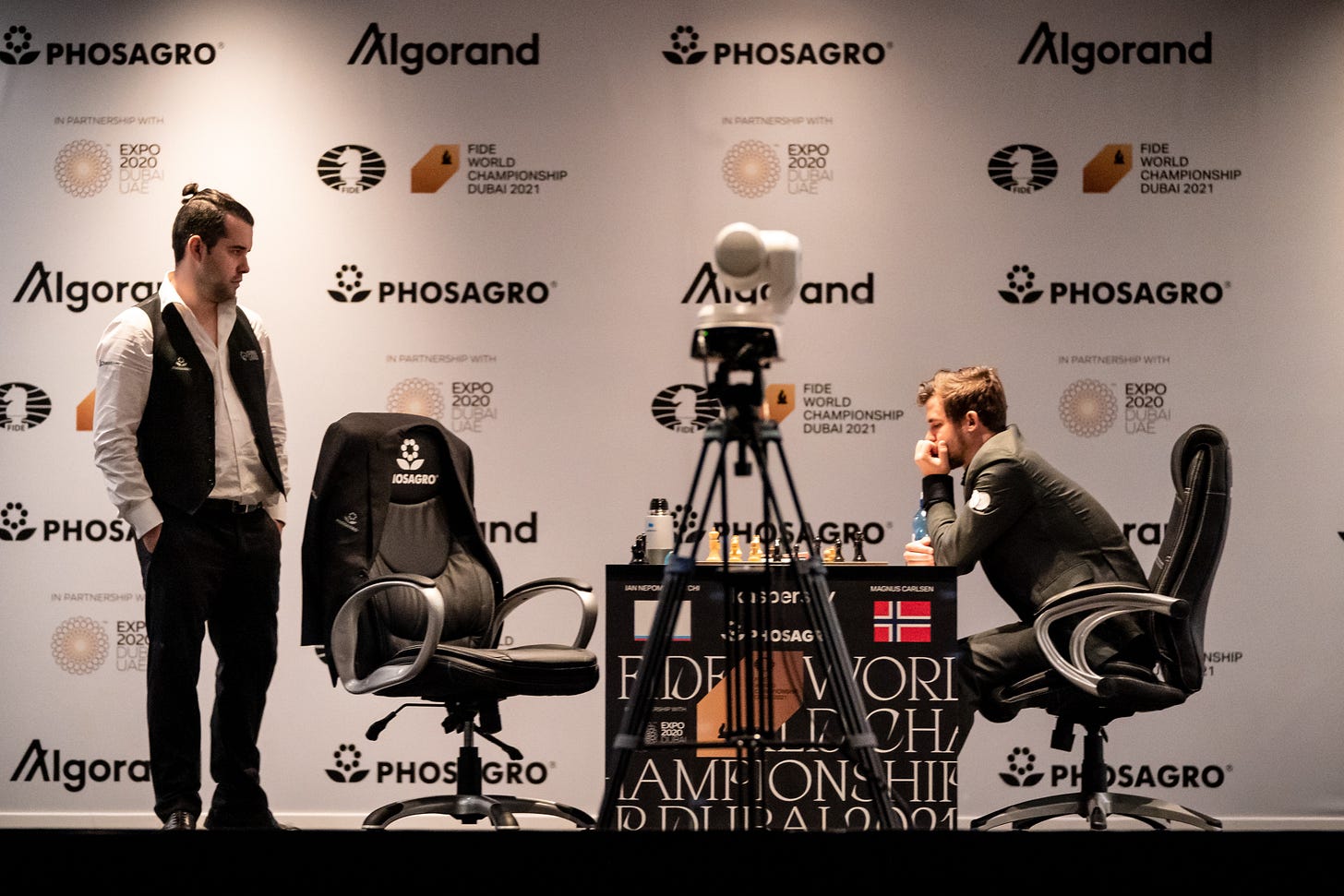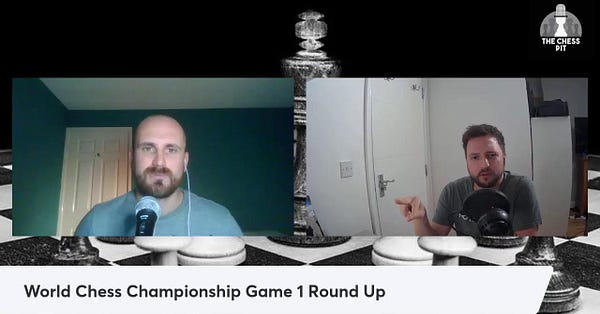Let There Be Chess (And There Was Chess)
The World Chess Championship lifted off with its first game as we moved from No Chess to Chess.
There’s a strange, elusive magic to football stadiums in the hours before a big game. You can’t touch or taste or smell or hear the eruption, but somehow you can sense it. You couldn’t yet picture Mo Salah crying with anguish on the turf, Gareth Bale flying through the night sky like a comet, Loris Karius grasping at the ball like a man trying to catch snow. But you could feel its heft in the void that preceded it. There’s a potential there, an implication, a tautness and an emptiness. The bigger the game, the bigger the emptiness.
Jonathan Liew, The Independent
Before Game 1 of the World Chess Championship got under way, there was a void. The President of FIDE had pushed the e-pawn forward two spaces. The formalities had been completed. The photographers had been ushered out of the room. Both players had filled in their score sheets. And then the World Champion Magnus Carlsen paused.
There are these moments with sporting events. Moments that precede them in which the watchers find themselves caught in the liminal space between the pure potentiality of “what could be” and the raw reality of “what is”. Before these events take place, we fill out the void with the narratives we spin. We like to imagine what will happen. We talk about Carlsen’s heritage. His litany of World Championships Past. We talk about the historical records of Carlsen and Nepomniachtchi. We talk about the psychology of the players. We concoct Damascus Road experiences which leave Nepomniachtchi 10kg lighter and more focused than ever before. Running out of things to talk about, we turn our minds to the future and talk about Alireza Firouzja’s inevitable appearance on the same stage.
But in that moment with Carlsen settling in front of the board, all those moments had been lost in time. We were about to make the shift from No Chess to Chess.
The sports writer Jonathan Liew has talked about this evacuative moment; the emptying of all our narratives from the equation and the pure potentiality of the moment before:
There’s a potential there, an implication, a tautness and an emptiness. The bigger the game, the bigger the emptiness.
And there is no bigger game than this in chess. No bigger emptiness. Nothing more at stake in the careers of these two men at this moment. The tautness stretched to a breaking point. Our computer models lie ignored and forgotten. The “Magnus is favourite but Nepo could surprise us” drift away into the ether. Nothing remains but formlessness and a void.
And there was chess. Carlsen pushed his e-pawn. Nepomniachtchi responded with his knight on g1. Carlsen with his knight on b8. Bishop to b5. Spanish. We knew it. The moves blitzed out. No Berlin. No Marshall. A closed Spanish. But just as we were settling in to the main line, we were immediately taken out of it. Knight to a5. This was going to be anything but a regular line.
And there was chess! Much of it prepared chess. Some of it unprepared—at least when it came to the malperformance of the DGT board which kept the pundits on their toes. But much of it prepared. With the swift move 14. King f1, Nepomniachtchi earned the admiration of the commentators. Even within this novel line of Carlsen’s, the Russian was still ‘in book’ deep into the game.
An endgame was reached. Carlsen was a pawn down. But he had, so the commentators liked to stress, ‘compensation’. In the post-game press conference, Carlsen was careful to point out that this is no mean feat: “You can only play with a pawn down if you’re comfortable playing a pawn down.” What was this compension? A bishop pair. Good development. Plenty of ideas. And black with a doubled pawn on the b-file.
From here the game gently percolated. At first, Peter Svidler and Vladimir Kramnik liked black’s position. In the early endgame, Nepomniachtchi “shuffled his pieces around” where “Carlsen had moved his pieces to good places”. And yet, despite this, Carlsen couldn’t seem to make headway. Nepomniachtchi himself had opportunities to simplify which he turned down. This wasn’t going to be an early rolling over from the challenger; he wanted to show he was here for real.
The first critical juncture in the endgame came with Nepomniachtchi’s decision to break Carlsen’s monopoly on the bishops. With one of the bishops gone, Carlsen was happy to give up both. The position simplified. But Carlsen still seemed to have his compensation.
And then the gregarious Nepomniachtchi seemed to take a step back. A knight was moved onto his back rank. Carlsen leaned forward. The b-file started looking precarious. A long think. 11-and-a-half minutes. And then Nepomniachtchi’s king went for a walk. A rook was repelled. The pendulum had swung back.
A few consolidating moves later and the players fell into a threefold repetition. A draw. There was chess. And the chess was good.
The void filled. The tautness slackened. The potential fulfilled. The challenger had given a good account of himself. The World Champion had looked to generate a winnable endgame. Both had entertained.
We go, then, from No Chess to Chess. Game 2 will come soon enough. Carlsen will take the white pieces. The implication is becoming a reality. The World Championship is underway.
If you want to get a daily update on the big picture of the World Chess Championship, why not try out The Chess Pit’s daily digest:





